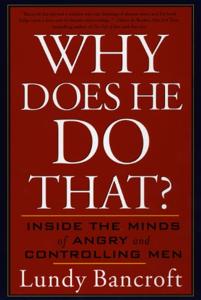
Want to learn the ideas in Why Does He Do That better than ever? Read the world’s #1 book summary of Why Does He Do That by Lundy Bancroft here.
Read a brief 1-Page Summary or watch video summaries curated by our expert team. Note: this book guide is not affiliated with or endorsed by the publisher or author, and we always encourage you to purchase and read the full book.
Video Summaries of Why Does He Do That
We’ve scoured the Internet for the very best videos on Why Does He Do That, from high-quality videos summaries to interviews or commentary by Lundy Bancroft.
1-Page Summary of Why Does He Do That
Overview
This book is for people who have experienced or are experiencing intimate partner violence and abuse. The author explains the types of abuse, including physical, emotional, financial, verbal, and sexual abuse. He also gives insights into why abusive behaviors occur in relationships by examining the underlying reasons behind them. This book is written specifically for women because it focuses on how men view their partners as well as how they treat them.
2-4 million women are abused in the United States each year. They suffer emotional and psychological damage, which can lead to a negative self-image and family problems.
Abusive men try to control their partners. They think that they are more important than their partners, and this is the heart of why they abuse them. Abusive men often deflect blame onto their partners or get angry in order to distract from the fact that they feel entitled to control their partners.
There are many different types of abusers. Some men, like Mr. Sensitive, can be very good at expressing their feelings and appear to be sympathetic to women in general. However, his actions often show that he is actually abusive toward his partner: for example, he may become moody when she doesn’t do what he wants her to do and will make sure that the focus of the relationship is on him rather than on her or anything else they might share together. Another type of abuser is The Player who surrounds himself with women and keeps his partner guessing as to whether or not he has been faithful; this way, no matter what happens between them later on down the road (or even if nothing happens), she’s always second-guessing herself about him. A third type of abuser is The Water Torturer who rarely loses his temper but wages a campaign of passive aggression against his partner so that when she gets upset at how he treats her, it’s easier for him to claim innocence because there were no visible signs that something was wrong—only subtle ones which most people don’t notice right away.
Abusive men are not interested in a relationship that is based on respect and equity. They might try to excuse their abuse by blaming it on something else, like an addiction or childhood trauma. However, the real issue is control: they want to maintain control over their partner.
People who are violent often feel remorse for their actions and make promises to change. However, this is part of the cycle of violence because victims believe that if they behave properly, the abuse will stop. Victims try to be more understanding or plead with their abusers to change. Couples therapy won’t help because it’s intended for problems between two people and not one person abusing another. The only way a victim can end the cycle of violence is by leaving or getting legal sanctions against their abuser.
Abusers need specialized treatment that targets their abusive beliefs. However, even those programs may not work. It’s not uncommon for an abuser to look like they’re getting better and then relapse into the same behaviors once the program is over. Real and lasting change can only happen when there are consequences for the behavior, education about its causes, and confrontation on negative attitudes.
It’s important for abused women to focus on themselves, rather than trying to change their abusers. Women who are abused have low self-esteem and doubt their perceptions. This is the outcome that the abuser aims for. Focusing on one’s own experiences will help them regain a sense of safety and heal from abusive experiences with support.






